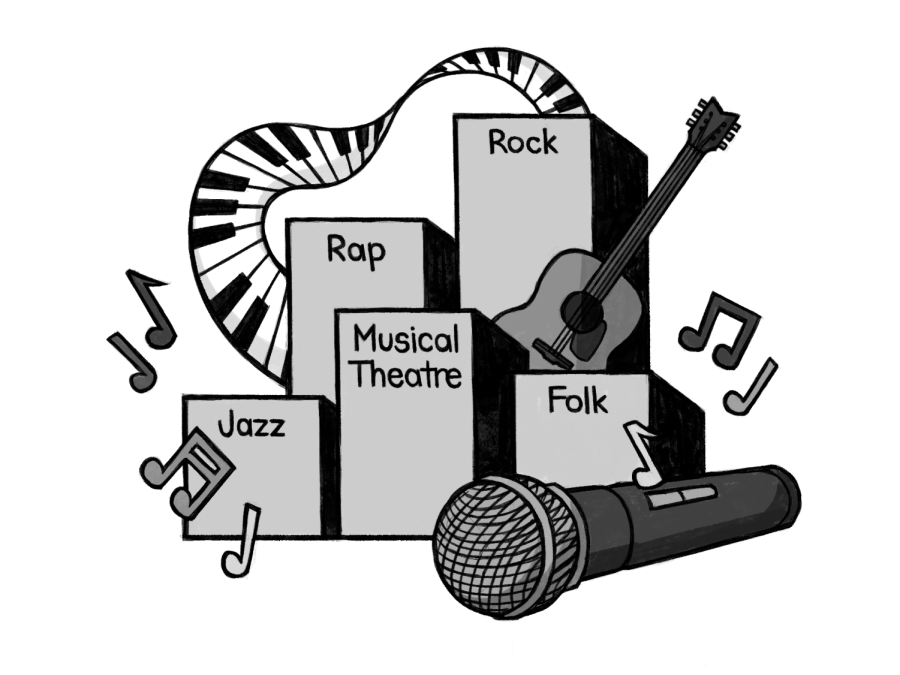A&E: From Jazz to Taylor Swift
Students find value in lyricism.
Music has played a large role in society for many years, evolving throughout time in technique and variety. Many people favor a few of its numerous categories, whether due to family ties, experience in the industry or preference in melody. The students and staff of SCHS are no exception, sharing their opinions and interpretations of music genres.
Senior Anika Hnizdo prizes classic, alternative and punk rock for its authenticity and impactful lyrics, most notably compared to more modern, mainstream pop songs.
“Hearing songs on the radio, it’s a lot of the same rhymes, a lot of the same words,” Hnizdo said. “So when you hear something that’s completely different, words you never thought that people would write together, it’s like (…) that’s not a word I thought would be in a song.”
She values the lyricism and musicality that make up a song, along with the importance of a genuine feeling in the piece of music.
“When things are like natural instruments, there’s a sincerity to it that you wouldn’t get in other kinds of music, which is why I really like rock,” Hnizdo said. “It’s a really raw kind of sound.”
A good example, Hnizdo explained, is “Jesus of Suburbia,” a nine-minute, early 2000s song by Green Day. Using vocals on top of guitar, bass and drums, the piece is often described as a narrative, similar to plays performed in the theater.
“It is like a punk rock opera, in that sense where it’s not telling a story,” Hnizdo said. “There is a story and you have to find it. That’s the difference between opera and musical theatre: in opera, the story happens through action and not the lyrics.”
In recent years, the popularity of musical theatre and the size of its fanbase has increased. Sophomore Venice Ella Mayor considers the genre one of their favorites, alongside folk and classical. Her experience in performing and playing piano is a source of preference.
“For musical theatre, a lot of it comes from nostalgia and lyricism. And then classical music. It’s the music theory that comes behind it,” Mayor said. “In a lot of instances it’s the root of a lot of music, and it’s really interesting to listen to and see it paraphrased in popular culture.”
The popular culture includes much of artist Taylor Swift’s content, one of Mayor’s most prominent idols. The singer and songwriter has delved into various genres of pop, country and most recently, folk.
“Her music and lyricism has really changed, and it’s really matured. It starts from a lot of first-person experiences, and she goes on to write in third person, and then she goes on to not even write about herself; she goes on to write about her house,” Mayor said. “I think that’s why a lot of people have started to enjoy her now.”
Inclination towards a genre for theater teacher Angelo Reyes is more fluid, depending on the current situation. However, he feels closest to rap, jazz and R&B, partially due to his father’s frequent listens.
Reyes finds that rap focuses on the communication of information and experiences of the artist.
“It’s very artistic, very creative,” Reyes said. “I think that it started because of where they were growing up, and they wanted to talk about, bring attention to what was going on in their neighborhoods.”
Some believe jazz is a stark contrast to rap, more involved in the melodies than the lyrics, but it still conveys something to the audience. Reyes stated that it is a genre of ease, often meant to set a calming atmosphere.
“I think that with jazz, it’s more displaying your artistry with playing instruments,” Reyes said. “Whether it’s a flute or a trumpet or whatever the case is, it shows how innovative they can be with the sounds that they can create.”
The flexibility and evolution portrayed in the music of jazz, folk and rock go to show each genre’s character. Why a type of music is valued is up to the individual’s interpretation. Hnizdo recounts her love for rock and the frequently incorporated lyrical narratives.
“When there’s freedom of structure in songs, there’s just so much more creative availability of what you can do,” Hnizdo said. “So when there’s that variability, there’s always something new and interesting. That’s why I love it.”


